
SCD831
SCD833
SCD835
SCD620
Page is loading ...

1
16
2
3
4
5
13
14
12
11
6
9 1087
17
18
22
20
19
21
23
25
24
15

Page is loading ...

Disclaimer
Please note that you use this baby monitor at your own risk. Koninklijke
Philips N.V. and its subsidiary companies are not responsible for the
operation of this baby monitor or your use of it and therefore do not accept
any liability in connection with your use of this baby monitor.
Danger
-
Never immerse any part of the baby monitor in water or any other liquid.
Do not place the appliance where water or any other liquid can drip or
splash onto it. Never use the baby monitor in moist places or close to
water.
-
Never put any object on top of the baby monitor and do not cover it. Do
not block any ventilation openings. Install according to the
manufacturer’s instructions.
-
Cords present a potential strangulation hazard. Keep cords out of the
reach of children (more than 1 meter/3.5 feet away). Never place the baby
monitor inside the baby’s bed or playpen.
Warning
-
Check if the voltage indicated on the adapter corresponds to the local
mains voltage before you connect the appliance.
-
Do not modify or cut off any part of the adapter and its cord, as this
causes a hazardous situation.
-
Only use the adapter supplied.
-
If the adapter is damaged, always have it replaced with one of the
original type in order to avoid a hazard.
-
This appliance can be used by children aged from 8 years and above and
persons with reduced physical, sensory or mental capabilities or lack of
experience and knowledge if they have been given supervision or
instruction concerning use of the appliance in a safe way and understand
the hazards involved. Children shall not play with the appliance. Cleaning
and user maintenance shall not be made by children without supervision.
-
Protect the mains cord from being walked on or pinched particularly at
plugs, convenience receptacles, and the point where they exit from the
appliance.
-
Make sure that you place the baby monitor in such a way that its cord
does not obstruct a doorway or passage. If you place the baby monitor
on a table or low cabinet, do not let the mains cord hang over the edge
of the table or cabinet. Make sure the cord does not lie on the floor
where it presents a tripping hazard.
-
Keep the packaging materials (plastic bags, cardboard buffers, etc.) out of
the reach of children, as they are not a toy.
-
To prevent electric shock, do not open the housing of the baby unit or
parent unit.
Caution
-
Use the appliance at a temperature between 0°C (32°F) and 40°C (104°F).
-
Do not install the appliance near any heat sources such as radiators, heat
registers, stoves or other apparatus (including amplifiers) that produce
heat.
7
English

-
Make sure that your hands are dry when you handle adapters, plugs and
the mains cord.
-
All required markings on the baby unit, parent unitand power adapter
are located on the bottom of the baby unit, parent unit and power
adapter.
Compliance with standards
-
This product complies with the radio interference requirements of the
European Community.
-
Philips Consumer Lifestyle hereby declares that this baby monitor is in
compliance with the essential requirements and other relevant provisions
of Directive 2014/53/EU (FHSS: frequency band 2.4GHz, maximum radio-
frequency power: 100 mW EIRP). A copy of the EC Declaration of
Conformity (DoC) is available online at www.philips.com/support.
Electromagnetic fields (EMF)
This Philips appliance complies with all applicable standards and
regulations regarding exposure to electromagnetic fields.
Preparing for use
Baby unit
Put the power adapter in the baby unit and the adapter in the wall socket.
Parent unit
The parent unit runs ona built-in rechargeable Li-ion battery.
Follow the below steps to charge the parent unit:
1 Put the power adapter in the parent unit and put the adapter in the wall
socket.
-
The battery status light turns orange to indicate that the appliance is
charging.
8
English

20°CEco
1
-
When the battery is fully charged, thebattery statusindicator lights up
green continuously.
10 hrs=3 hrs
-
When you charge the parent unit for 3 hours, it can be used cordlessly for
approx. 10 hours.
-
If the parent unit is switched on during charging, charging takes
approximately twice as long.
20°CEco
1
-
When the rechargeable battery of the parent unit is almost empty, the
battery status light turnsred and the parent unit beeps.
-
If the battery is completely empty and the parent unit it not connected to
the mains, the parent unit automatically switches off and loses contact
with the baby unit.
Note: The built in rechargeable battery cannot be removed from the
product.
Note: The battery gradually and very slowly discharges, even when the
parent unit is switched off.
Tip: To save battery, switch off the parent unit when you do not use it.
Note: We advise you to keep the parent unit connected to the mains during
the whole night. If the battery of the parent unit runs low during the night,
the parent unit beeps and this may wake you up.
Using the baby monitor
Linking parent unit and baby unit
1 Push the on/off slide on the baby unit upwards to the ON position.
9
English

2 When the baby unit is on, the power-on light on the baby unit lights up
green.
Note: The power-on light on the baby unit always lights up green, even
when there is no connection with the parent unit.
>2.5m/8.2ft
3 Make sure that the parent unit and the baby unit are at least 2.5 meters/
8.2 feet away from each otherto avoid acoustic feedback.
4 Press the on/off button on the parent unit to switch on the parent unit.
20°CEco
1
-
The display goes on, the linking image appears on the display and the
link light lights up red. The parent unit starts to search for the baby
unit.
20°CEco
1
-
When the parent unit and baby unit are linked, the link light lights up
green on the parent unit and one or more bars appear on the display.
10
English

20°CEco
1
Note: It takes less than 10 seconds to establish the link between the
parent unit and the baby unit.
When thebaby unit is turned off, the parent unit will show the out of
range image. Make sure that the baby unit is switched on.
-
If no connection has been established, the link light turns red, the
parent unit beeps three short beeps every 20 seconds and the out-of-
range image appears on the display.
Positioning the baby monitor
Warning: The cord of the baby unit presents a potential
strangulation hazard. Make sure that the baby unit and its cord
are at least 1 meter / 3.5 feet away from your baby. Never place
the baby monitor inside the baby’s bed or playpen.
>1-1.5m/3.5-5ft
1 For optimal sound detection, make sure that the baby unit is no further
than 1.5 meter/ 5 feet away from the baby. Make sure that the baby unit
is at least 1 meter/ 3.5 feet away from the baby because of potential
strangulation hazard.
>2.5m/8.2ft
2 Place the parent unit within the operating range of the baby unit. Make
sure it is at least 2.5 meters / 8.2 feet away from the baby unit to avoid
acoustic feedback.
Note: If you use a cordless phone, wireless video, Wi-Fi network,
microwave oven or Bluetooth on 2.4GHz and you experience
interference on either the parent unit or baby unit, move the parent unit
until there is no more interference.
3 There are two ways to position the baby unit
a Place the baby unit on a stable, level and horizontal surface.
b Mount the baby unit to the wall with screws.
11
English

Tip: The wall mount template (see 'Wall mount') to mount the baby unit
to the wall can be found at the end of this user manual.
Tip: Use the provided template to mark the exact location of the screw
holes on the wall.
Tip: Position the baby unit at a higher level to get a good overview of the
baby’s bed or playpen.
4 Adjust the baby unit in a way that ensures the best visibility of your baby.
The baby unit can be rotated to position it in the desired way.
Dry materials Material thickness Loss of range
Wood, plaster, cardboard, glass (without metal,
wires or lead)
< 30cm (12in) 0-10%
Brick, plywood < 30cm (12in) 5-35%
Reinforced concrete < 30cm (12in) 30-100%
Metal grilles or bars < 1cm (0.4in) 90-100%
Metal or aluminium sheets < 1cm (0.4in) 100%
Operating range
<300m/985ft
<50m/165ft
The operating range is up to 50 meters/ 165 feet indoors and 300
meters/985 feet outdoors. The operating range of the baby monitor varies
depending on the surroundings and factors that cause interference. Wet
and moist materials cause so much interference that the range loss is up to
100%.
12
English

Features and settings
Volume
You can adjust the speaker volume of the parent unit to the level you prefer.
1 Press the top or bottom part of the control button to adjust the volume.
20°C
1
Tip: Make sure that the volume is adapted to the current conditions.
Under noisy conditions, the vibration alert can be turned on as well.
The volume bar appears on the display to show the selected volume.
Note: If the volume is set to a high level, the parent unit consumes more
power.
Note: When the volume bar is at its minimum, the volume is muted. The
parent unit shows a mute icon in the status bar and you will only receive
alerts and video from the parent unit.
Brightness
You can adjust the display brightness of the parent unit to the level you
prefer.
1 Press the left or right part of the control button to adjust the brightness
of the display of the parent unit.
20°C
1
The brightness bar appears on the display to show the selected display
brightness.
Note: If the brightness is set to a high level, the parent unit consumes more
power.
13
English

Modes
This baby monitor has four different modes that allows you to choose how
you want to look after your baby: VIDEO, AUDIO, VOX and ECO.
With the baby monitor on, you can switch between these 4 different modes
by pressing the mode button on the side of the parent unit.
The display shows the selected mode. The selected mode is also indicated
in the status bar. When turning on the device, the mode that was last used
will be active.
VIDEO mode
VIDEO
VIDEO
Press the mode button on the side of the parent unit to select theVIDEO
mode.
20°C
1
VIDEO
When the VIDEO mode is activated, the screen is always on, so you can see
your baby. All sounds are directly transmitted to the parent unit.
20°C
1
VIDEO
Note: Set the sensitivity level to 'very high' to have continuous sound on the
parent unit. Please see the Sensitivity level chapter for more information.
14
English

AUDIO mode
AUDIO
AUDIO
1 Press the mode button on the side of the parent unit to switch to AUDIO
mode.
20°C
1
AUDIO
When the AUDIO mode is activated, the display of the parent unit switches
off. After 3 seconds the display will completely turn off and the status bar
will disappear.
Note: The status bar is not visible when the display is off.
20°C
1
AUDIO
Note: The link light shows that the parent unit is still on and connected to
the baby unit.
Note: Set the sensitivity level to 'very high' to have continuous sound on the
parent unit. Please see the Sensitivity level chapter for more information.
All sounds are constantly transmitted to the parent unit. If your baby cries,
the display of the parent unit is still off, but the sounds detected by
thebaby unitare transmitted to the parent unit.
VOX mode
VOX
VOX
1 Press the mode button on the side of the parent unit to switch to VOX
mode.
Note: When the display is on, the selected mode is shown in the status bar.
The status baris not visible when the display is off.
20°C
1
AUDIO
When the VOX mode is activated, the display and sound of the parent unit
switch off, if there is no sound detected for 20 seconds.
15
English

20°C
1
VOX
Whensound is picked up by the baby unit, the displayand sound of the
parent unit switch on immediately.The sounds are transmitted to the parent
unit.
Note: The minimum sound level to activate sound and display is defined by
the sensitivity setting.
ECO mode
ECO
ECO
1 Press the mode button on the side of the parent unit to switch to ECO
mode.
Note: When the display is on, the selected mode will be visible in the status
bar. The status bar is not visible when the display is off.
20°C
1
ECO
ECO
When the ECO mode is activated the display and sound of the parent unit
switch off when no sound is detected for 20 seconds. TheECO light lights up
green to indicate that the ECO mode is activated. During ECO mode the
display and sound transmissions are turned off.
20°C
1
ECO
Whensound is picked up by the baby unit, the displayand sound of the
parent unit switch on immediately.The sounds are transmitted to the parent
unit.
Note: The minimum sound level to activate sound and display is defined by
the sensitivity setting.
Lullabies
You can activate the lullaby feature either from the parent unit or from the
baby unit.
To activate the lullaby feature from the parent unit, follow the instructions
below:
16
English

Lullaby selection
1 Press the lullaby button on the parent unit to open the menu for
lullabies.
Note: Pressing the lullaby button while the lullaby menu is already open,
will close the menu.
2 Press the right part of the control button to enter the list of lullabies.
Lullaby Songs
1 Rock-a-Bye Baby
2 Twinkle, Twinkle
3 Hush, Little Baby
4 Brahm’s Lullaby
5 Golden Slumbers
3 Press the top or bottom part of the control button to scroll through the
list of lullabies.
Lullaby Songs
1 Rock-a-Bye Baby
2 Twinkle, Twinkle
3 Hush, Little Baby
4 Brahm’s Lullaby
5 Golden Slumbers
4 Press the right part of the control button to play a specific lullaby.
If you want to pause the lullaby, press the right side of the control button
again.
5 The status barof the parent unit shows the number of lullabies thatare
being played and repeated.
15 min
The lullaby starts to play on the baby unit and it is repeated continuously
for approximately 15 minutes.
Tip: To repeat all songs that are available, select the last option in the list.
17
English

Lullaby Songs
1 Rock-a-Bye Baby
2 Twinkle, Twinkle
3 Hush, Little Baby
4 Brahm’s Lullaby
5 Golden Slumbers
6 To select another lullaby, scroll up or down with thecontrol button to
select another song from the list.Press the right part of the control
button to start the selected song.
7 To stop the lullaby, press the lullaby button on the parent unit and pause
the song that is currently playing by pressing the right part of the control
button one more time.
Lullaby volume
20°C
1
Lullaby Volume
VIDEO
1 Press the lullaby button and then press the bottom of the control button
to select the volume options of thelullaby menu. Press the right part of
the control button to access the lullaby volume levels.
20°C
1
Lullaby Volume
VIDEO
2 Press the top or bottom part of the control button to adjust the volume.
To activate the lullaby feature from the baby unit, press the lullaby on/off
button on the baby unit.
15 min
The latest lullaby selected on the parent unit starts to play on the baby unit
and is repeated continuously for approximately 15 minutes.
To stop the lullaby on the baby unit, press the lullaby on/off button on the
baby unit.
18
English

Talk-back
You can use the talk-back button on the parent unit to talk to your baby.
1 Press and hold the talk-back button on the parent unit.
2 Talk clearly into the microphoneat the front of the parent unit from a
distance between 15-30cm /0.5-1ft.
As long as the talk-back button is pressed, there is an open sound
connection to the baby unit. The display of the parent unit shows the
talk-back icon, indicating the active connection.
3 Release the talk-back button when you have finished talking.
Note: As long as the talk-back button is pressed, theparent unitcannot
process sounds coming from the baby unit.
Sensitivity
The sensitivity level of the baby unit defines what you hear through the
parent unit. When the level is set high, you will hear many sounds, including
soft background sounds. When the sensitivity level is set low, you will hear
only the louder sounds.
1 Press the sensitivity button to access the sensitivity levels.
Note: When pressing the sensitivity button again, you will leave the menu.
20°C
1
2 Press the top or bottom part of the control button to select the desired
sensitivity level.
19
English

20°C
1
If your baby only makes soft sounds, the sensitivity of the baby unit needs
to be set to a high sensitivitylevel on the parent unit.
20°C
1
The louder your baby sounds, the lower the sensitivity can be set on the
parent unit.
Note: In AUDIO and VIDEO mode, you will have continuous sound when the
sensitivity level is on 'very high'. Otherwise, low sounds will be muted.
Tip: The sensitivity level can be adjusted so you will always hear your baby
without the disruption of other sounds. When there is a lot of background
noise, turn the sensitivity lower so you will not hear these sounds through
the parent unit.
Belt clip
You can take the parent unit with you inside and outside the house by
attaching the parent unit to your belt or waistband with the belt clip. This
allows you to monitor your baby while you are moving around.
Note: The display is now turned upside down, which allows you to see your
baby on the screen by simply lifting up the parent unit.
Cleaning and maintenance
Warning: Do not immerse the parent unit, baby unit and power
adapters in water and do not clean them under the tap.
20
English

Warning: Do not use cleaning sprays or liquid cleaners.
1 Switch off the baby unit, remove the power adapter from the baby unit
and remove the power adapter from the wall socket.
2 Clean the baby unit with a dry cloth.
Note: Fingerprints or dirt on the lens of the baby unit may affect the
camera’s performance. Avoid touching the lens with your fingers.
3 Switch off the parent unit, remove the power adapter from the parent
unit and remove the power adapter from the wall socket.
4 Clean the parent unit with a dry cloth.
21
English

5 Clean the adapters with a dry cloth.
Storage
When you are not going to use the baby monitor fora long time, store the
parent unit, the baby unit and the adapters in a cool and dry place.
Ordering accessories
To buy accessories or spare parts, visit www.philips.com/parts-and-
accessories or go to your Philips dealer. You can also contact the Philips
Consumer Care Center in your country (see the international warranty leaflet
for contact details).
Recycling
-
This symbol means that this product shall not be disposed of with normal
household waste (2012/19/EU).
-
This symbol means that this product contains a built-in rechargeable
battery which shall not be disposed of with normal household waste
(2006/66/EC). Please take your product to an official collection point or
a Philips service center to have a professional remove the rechargeable
battery.
-
Follow your country’s rules for the separate collection of electrical and
electronic products and rechargeable batteries. Correct disposal helps
prevent negative consequences for the environment and human health.
Removing the rechargeable battery
Note: We strongly advise you to have a professional remove the
rechargeable battery.
Only remove the rechargeable battery when you discard the appliance.
Make sure the battery is completely empty when you remove it. Only the
parent unit includes a battery.
Procedure:
1 Remove the 2 rubber feet at the bottom of the parent unit.
22
English
Page is loading ...
Page is loading ...
Page is loading ...
Page is loading ...
Page is loading ...
Page is loading ...
Page is loading ...
Page is loading ...
Page is loading ...
Page is loading ...
Page is loading ...
Page is loading ...
Page is loading ...
Page is loading ...
Page is loading ...
Page is loading ...
Page is loading ...
Page is loading ...
Page is loading ...
Page is loading ...
Page is loading ...
Page is loading ...
Page is loading ...
Page is loading ...
Page is loading ...
Page is loading ...
Page is loading ...
Page is loading ...
Page is loading ...
Page is loading ...
Page is loading ...
Page is loading ...
Page is loading ...
Page is loading ...
Page is loading ...
Page is loading ...
Page is loading ...
Page is loading ...
Page is loading ...
Page is loading ...
Page is loading ...
Page is loading ...
Page is loading ...
Page is loading ...
Page is loading ...
Page is loading ...
Page is loading ...
Page is loading ...
Page is loading ...
Page is loading ...
Page is loading ...
Page is loading ...
Page is loading ...
Page is loading ...
Page is loading ...
Page is loading ...
Page is loading ...
Page is loading ...
Page is loading ...
Page is loading ...
Page is loading ...
Page is loading ...
Page is loading ...
Page is loading ...
Page is loading ...
Page is loading ...
Page is loading ...
Page is loading ...
Page is loading ...
Page is loading ...
Page is loading ...
Page is loading ...
Page is loading ...
Page is loading ...
Page is loading ...
Page is loading ...
Page is loading ...
Page is loading ...
Page is loading ...
Page is loading ...
Page is loading ...
Page is loading ...
Page is loading ...
Page is loading ...
Page is loading ...
Page is loading ...
Page is loading ...
Page is loading ...
Page is loading ...
Page is loading ...
Page is loading ...
Page is loading ...
Page is loading ...
Page is loading ...
Page is loading ...
Page is loading ...
Page is loading ...
Page is loading ...
Page is loading ...
Page is loading ...
Page is loading ...
Page is loading ...
Page is loading ...
Page is loading ...
Page is loading ...
Page is loading ...
Page is loading ...
Page is loading ...
Page is loading ...
Page is loading ...
Page is loading ...
Page is loading ...
Page is loading ...
Page is loading ...
Page is loading ...
Page is loading ...
Page is loading ...
Page is loading ...
Page is loading ...
Page is loading ...
Page is loading ...
Page is loading ...
Page is loading ...
Page is loading ...
Page is loading ...
Page is loading ...
Page is loading ...
Page is loading ...
Page is loading ...
Page is loading ...
Page is loading ...
Page is loading ...
Page is loading ...
Page is loading ...
Page is loading ...
Page is loading ...
Page is loading ...
Page is loading ...
Page is loading ...
Page is loading ...
Page is loading ...
Page is loading ...
Page is loading ...
Page is loading ...
Page is loading ...
Page is loading ...
Page is loading ...
Page is loading ...
Page is loading ...
Page is loading ...
Page is loading ...
Page is loading ...
Page is loading ...
Page is loading ...
Page is loading ...
Page is loading ...
Page is loading ...
Page is loading ...
Page is loading ...
Page is loading ...
Page is loading ...
Page is loading ...
Page is loading ...
Page is loading ...
Page is loading ...
Page is loading ...
Page is loading ...
Page is loading ...
Page is loading ...
Page is loading ...
Page is loading ...
Page is loading ...
Page is loading ...
Page is loading ...
Page is loading ...
Page is loading ...
Page is loading ...
Page is loading ...
Page is loading ...
Page is loading ...
Page is loading ...
Page is loading ...
Page is loading ...
Page is loading ...
Page is loading ...
Page is loading ...
Page is loading ...
Page is loading ...
Page is loading ...
Page is loading ...
Page is loading ...
Page is loading ...
Page is loading ...
Page is loading ...
Page is loading ...
Page is loading ...
Page is loading ...
Page is loading ...
Page is loading ...
Page is loading ...
Page is loading ...
Page is loading ...
Page is loading ...
Page is loading ...
Page is loading ...
Page is loading ...
Page is loading ...
Page is loading ...
Page is loading ...
Page is loading ...
Page is loading ...
Page is loading ...
Page is loading ...
Page is loading ...
Page is loading ...
Page is loading ...
Page is loading ...
Page is loading ...
Page is loading ...
Page is loading ...
Page is loading ...
Page is loading ...
Page is loading ...
Page is loading ...
Page is loading ...
Page is loading ...
Page is loading ...
Page is loading ...
Page is loading ...
Page is loading ...
Page is loading ...
Page is loading ...
Page is loading ...
Page is loading ...
Page is loading ...
Page is loading ...
Page is loading ...
Page is loading ...
Page is loading ...
Page is loading ...
Page is loading ...
Page is loading ...
Page is loading ...
Page is loading ...
Page is loading ...
Page is loading ...
Page is loading ...
Page is loading ...
Page is loading ...
Page is loading ...
Page is loading ...
Page is loading ...
Page is loading ...
Page is loading ...
Page is loading ...
Page is loading ...
Page is loading ...
Page is loading ...
Page is loading ...
Page is loading ...
Page is loading ...
Page is loading ...
Page is loading ...
Page is loading ...
Page is loading ...
Page is loading ...
Page is loading ...
Page is loading ...
Page is loading ...
Page is loading ...
Page is loading ...
Page is loading ...
Page is loading ...
Page is loading ...
Page is loading ...
Page is loading ...
Page is loading ...
Page is loading ...
Page is loading ...
Page is loading ...
Page is loading ...
Page is loading ...
Page is loading ...
Page is loading ...
Page is loading ...
Page is loading ...
Page is loading ...
Page is loading ...
Page is loading ...
Page is loading ...
-
 1
1
-
 2
2
-
 3
3
-
 4
4
-
 5
5
-
 6
6
-
 7
7
-
 8
8
-
 9
9
-
 10
10
-
 11
11
-
 12
12
-
 13
13
-
 14
14
-
 15
15
-
 16
16
-
 17
17
-
 18
18
-
 19
19
-
 20
20
-
 21
21
-
 22
22
-
 23
23
-
 24
24
-
 25
25
-
 26
26
-
 27
27
-
 28
28
-
 29
29
-
 30
30
-
 31
31
-
 32
32
-
 33
33
-
 34
34
-
 35
35
-
 36
36
-
 37
37
-
 38
38
-
 39
39
-
 40
40
-
 41
41
-
 42
42
-
 43
43
-
 44
44
-
 45
45
-
 46
46
-
 47
47
-
 48
48
-
 49
49
-
 50
50
-
 51
51
-
 52
52
-
 53
53
-
 54
54
-
 55
55
-
 56
56
-
 57
57
-
 58
58
-
 59
59
-
 60
60
-
 61
61
-
 62
62
-
 63
63
-
 64
64
-
 65
65
-
 66
66
-
 67
67
-
 68
68
-
 69
69
-
 70
70
-
 71
71
-
 72
72
-
 73
73
-
 74
74
-
 75
75
-
 76
76
-
 77
77
-
 78
78
-
 79
79
-
 80
80
-
 81
81
-
 82
82
-
 83
83
-
 84
84
-
 85
85
-
 86
86
-
 87
87
-
 88
88
-
 89
89
-
 90
90
-
 91
91
-
 92
92
-
 93
93
-
 94
94
-
 95
95
-
 96
96
-
 97
97
-
 98
98
-
 99
99
-
 100
100
-
 101
101
-
 102
102
-
 103
103
-
 104
104
-
 105
105
-
 106
106
-
 107
107
-
 108
108
-
 109
109
-
 110
110
-
 111
111
-
 112
112
-
 113
113
-
 114
114
-
 115
115
-
 116
116
-
 117
117
-
 118
118
-
 119
119
-
 120
120
-
 121
121
-
 122
122
-
 123
123
-
 124
124
-
 125
125
-
 126
126
-
 127
127
-
 128
128
-
 129
129
-
 130
130
-
 131
131
-
 132
132
-
 133
133
-
 134
134
-
 135
135
-
 136
136
-
 137
137
-
 138
138
-
 139
139
-
 140
140
-
 141
141
-
 142
142
-
 143
143
-
 144
144
-
 145
145
-
 146
146
-
 147
147
-
 148
148
-
 149
149
-
 150
150
-
 151
151
-
 152
152
-
 153
153
-
 154
154
-
 155
155
-
 156
156
-
 157
157
-
 158
158
-
 159
159
-
 160
160
-
 161
161
-
 162
162
-
 163
163
-
 164
164
-
 165
165
-
 166
166
-
 167
167
-
 168
168
-
 169
169
-
 170
170
-
 171
171
-
 172
172
-
 173
173
-
 174
174
-
 175
175
-
 176
176
-
 177
177
-
 178
178
-
 179
179
-
 180
180
-
 181
181
-
 182
182
-
 183
183
-
 184
184
-
 185
185
-
 186
186
-
 187
187
-
 188
188
-
 189
189
-
 190
190
-
 191
191
-
 192
192
-
 193
193
-
 194
194
-
 195
195
-
 196
196
-
 197
197
-
 198
198
-
 199
199
-
 200
200
-
 201
201
-
 202
202
-
 203
203
-
 204
204
-
 205
205
-
 206
206
-
 207
207
-
 208
208
-
 209
209
-
 210
210
-
 211
211
-
 212
212
-
 213
213
-
 214
214
-
 215
215
-
 216
216
-
 217
217
-
 218
218
-
 219
219
-
 220
220
-
 221
221
-
 222
222
-
 223
223
-
 224
224
-
 225
225
-
 226
226
-
 227
227
-
 228
228
-
 229
229
-
 230
230
-
 231
231
-
 232
232
-
 233
233
-
 234
234
-
 235
235
-
 236
236
-
 237
237
-
 238
238
-
 239
239
-
 240
240
-
 241
241
-
 242
242
-
 243
243
-
 244
244
-
 245
245
-
 246
246
-
 247
247
-
 248
248
-
 249
249
-
 250
250
-
 251
251
-
 252
252
-
 253
253
-
 254
254
-
 255
255
-
 256
256
-
 257
257
-
 258
258
-
 259
259
-
 260
260
-
 261
261
-
 262
262
-
 263
263
-
 264
264
-
 265
265
-
 266
266
-
 267
267
-
 268
268
-
 269
269
-
 270
270
-
 271
271
-
 272
272
-
 273
273
-
 274
274
-
 275
275
-
 276
276
-
 277
277
-
 278
278
-
 279
279
-
 280
280
-
 281
281
-
 282
282
-
 283
283
-
 284
284
-
 285
285
-
 286
286
-
 287
287
-
 288
288
-
 289
289
-
 290
290
-
 291
291
-
 292
292
-
 293
293
-
 294
294
-
 295
295
-
 296
296
-
 297
297
-
 298
298
-
 299
299
-
 300
300
-
 301
301
-
 302
302
-
 303
303
-
 304
304
-
 305
305
-
 306
306
-
 307
307
-
 308
308
-
 309
309
-
 310
310
-
 311
311
-
 312
312
Philips SCD833 User manual
- Category
- Babyphones
- Type
- User manual
Ask a question and I''ll find the answer in the document
Finding information in a document is now easier with AI
in other languages
- italiano: Philips SCD833 Manuale utente
- français: Philips SCD833 Manuel utilisateur
- español: Philips SCD833 Manual de usuario
- Deutsch: Philips SCD833 Benutzerhandbuch
- Nederlands: Philips SCD833 Handleiding
- português: Philips SCD833 Manual do usuário
- dansk: Philips SCD833 Brugermanual
- Türkçe: Philips SCD833 Kullanım kılavuzu
- svenska: Philips SCD833 Användarmanual
- suomi: Philips SCD833 Ohjekirja
Related papers
-
Philips SCD845/82 User manual
-
Philips SCD570/10 User manual
-
Philips SC479 User manual
-
Philips Avent SCD603/01 Digital Video Baby Monitor User manual
-
Philips SCD715/00 User manual
-
Philips SCD715/00 User manual
-
Philips SCD734/26 User manual
-
Philips AVENT SCD505 User manual
-
Philips scd 480 User manual
-
Philips SCD480 Owner's manual
Other documents
-
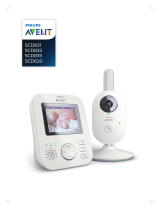 Philips AVENT SCD835/26 Owner's manual
Philips AVENT SCD835/26 Owner's manual
-
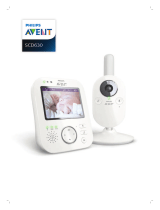 Avent SCD630/26 User manual
Avent SCD630/26 User manual
-
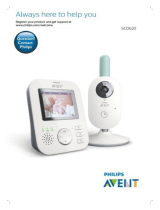 Avent SCD620/93 User manual
Avent SCD620/93 User manual
-
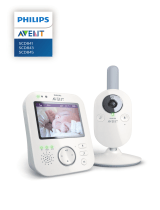 Avent SCD843/05 User manual
Avent SCD843/05 User manual
-
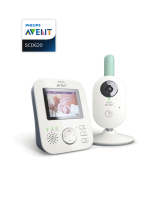 Avent SCD620/78 User manual
Avent SCD620/78 User manual
-
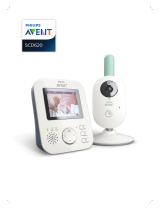 Avent SCD620/78 User manual
Avent SCD620/78 User manual
-
 Avent SCD620/93 Quick start guide
Avent SCD620/93 Quick start guide
-
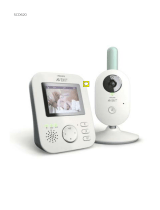 Philips AVENT SCD620 User manual
Philips AVENT SCD620 User manual
-
Levana LV-TW200 User manual
-
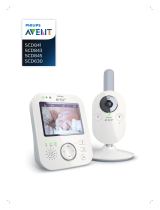 Philips AVENT SCD845/26 Owner's manual
Philips AVENT SCD845/26 Owner's manual

































































































































































































































































































































